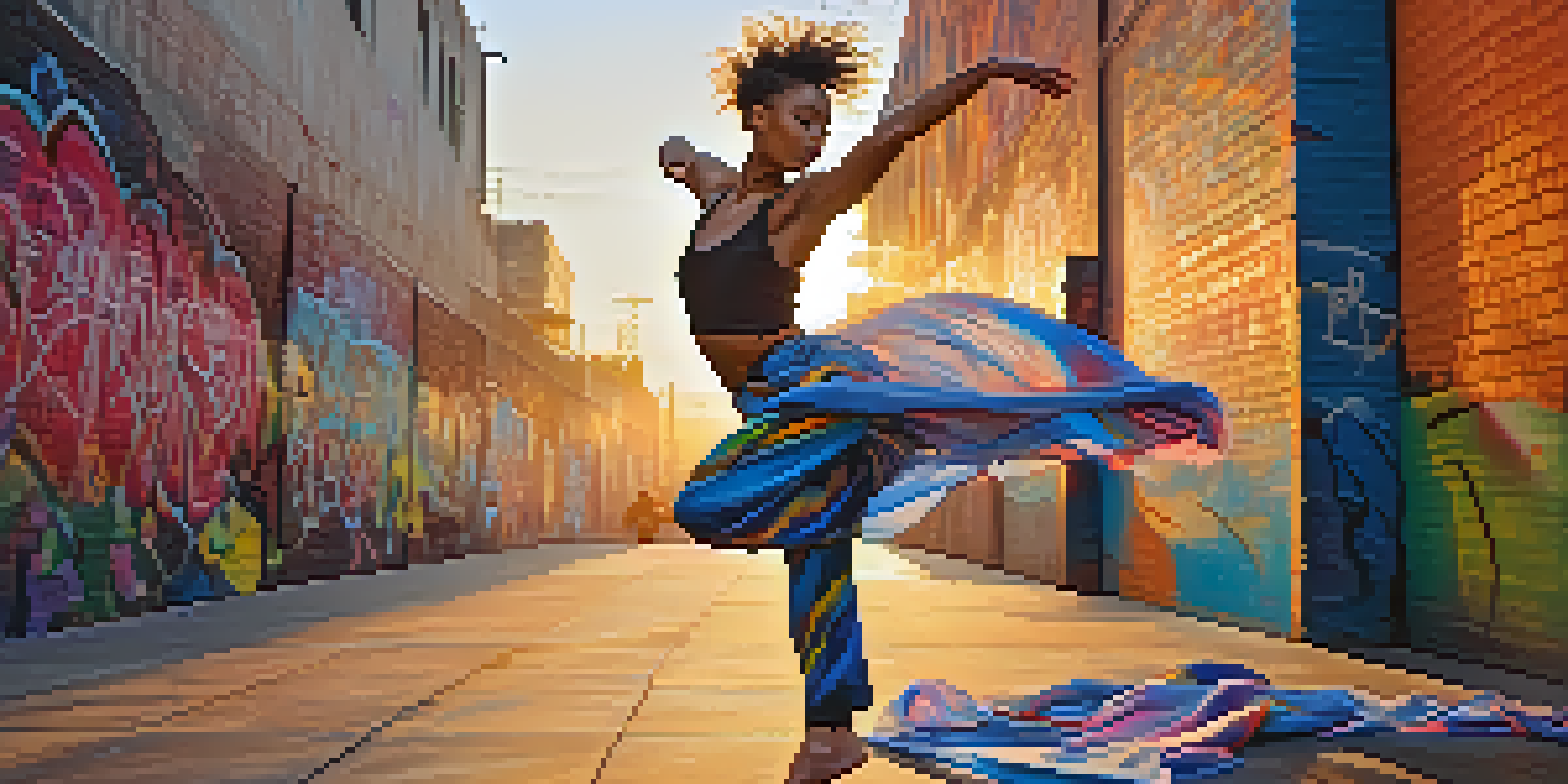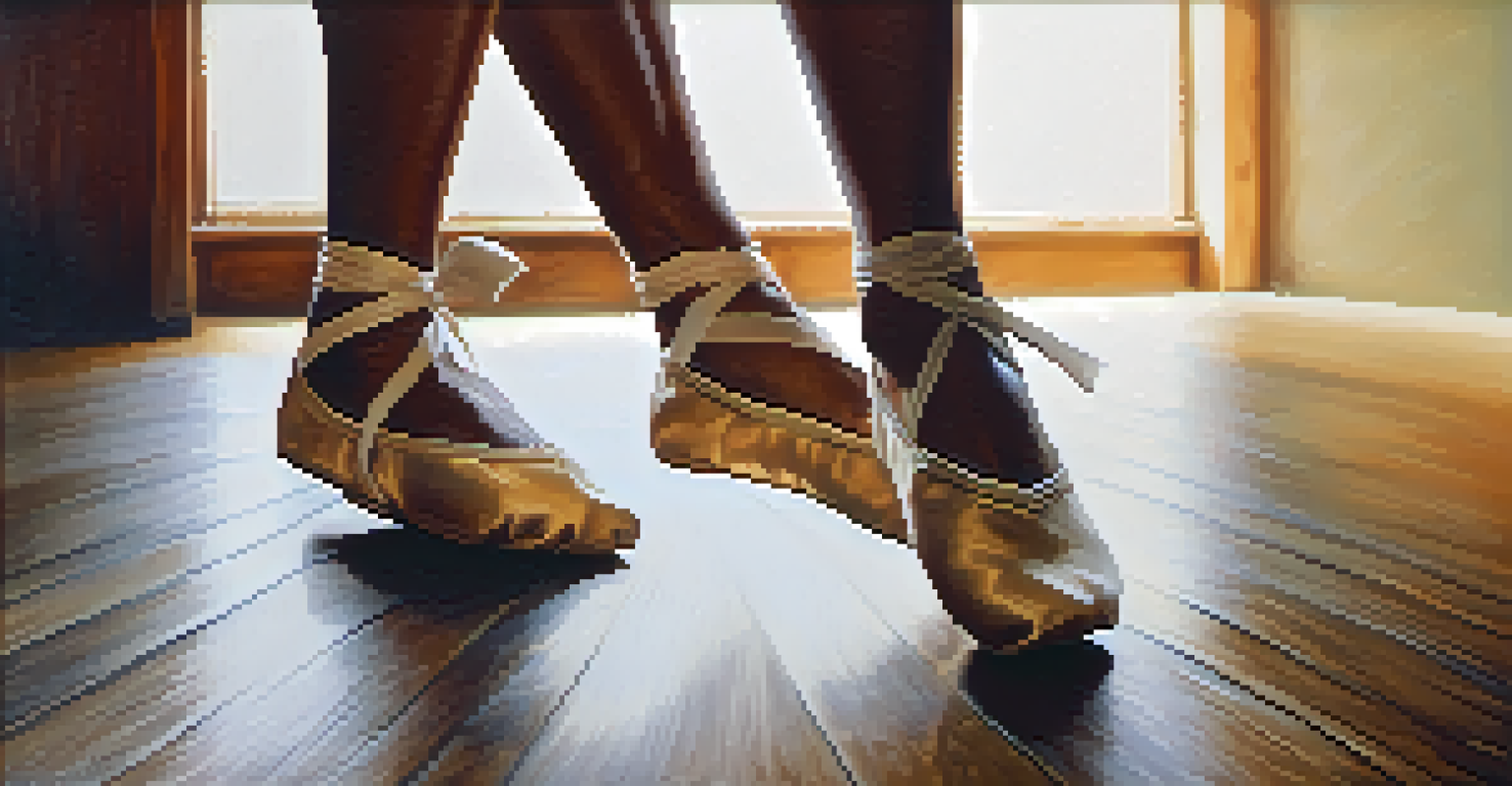Improvisation in Dance: Innovation through Spontaneous Movement

Understanding Improvisation in Dance: A Foundation for Creativity
Improvisation in dance is all about spontaneity and creativity. It's the art of moving without a predetermined plan, allowing dancers to express their emotions and ideas in the moment. This freedom can lead to unique performances that capture the essence of the dancer's thoughts and feelings.
Dance is the hidden language of the soul.
Think of it like jazz music, where musicians create melodies on the spot, responding to each other in real-time. Just as a jazz musician listens and reacts to their bandmates, dancers in an improvisational setting respond to their surroundings, music, and fellow performers. This dynamic interaction fosters a vibrant and organic atmosphere.
Ultimately, improvisation in dance serves as a playground for exploration. Dancers can push their boundaries, experiment with new movements, and discover fresh ways to communicate through their art. It's a practice that can lead to innovative techniques and styles, reshaping the dance landscape.
The Role of Intuition in Improvisational Dance
Intuition plays a crucial role in improvisational dance. Dancers often rely on their instincts to guide their movements, making decisions in the moment based on how they feel and what they sense. This reliance on intuition can lead to unexpected and beautiful outcomes, showcasing the dancer's true self.

Imagine walking through a forest and allowing your feet to guide you along a hidden path. In a similar way, dancers allow their bodies to navigate the space around them, responding to the music and energy in the room. This intuitive approach creates a sense of authenticity and vulnerability in their performance.
Improvisation Sparks Creativity
Improvisation in dance allows dancers to express emotions and ideas spontaneously, leading to unique and innovative performances.
Moreover, the ability to trust one's intuition can cultivate a deeper connection between the dancer and the audience. When performers let go of self-consciousness and embrace spontaneity, they invite viewers into their world, making each performance a shared experience that feels personal and alive.
Improvisation as a Tool for Collaboration in Dance
Improvisation shines particularly bright in collaborative dance settings. When multiple dancers come together, the spontaneous nature of improvisation allows for exciting interactions and exchanges. Each dancer brings their unique perspective, contributing to a collective experience that can evolve in surprising ways.
Improvisation is not a skill, it’s a state of mind.
Think of a group of friends brainstorming ideas for a project. Each person's input influences the direction of the conversation, leading to innovative solutions that wouldn't have emerged from a single viewpoint. In dance, this collaborative improvisation can produce mesmerizing group performances that highlight the strengths and styles of each dancer.
Moreover, improvisation fosters a sense of trust and camaraderie among dancers. As they explore movements together, they learn to communicate non-verbally, enhancing their ability to work as a cohesive unit. This synergy not only enriches the performance but also strengthens relationships within the dance community.
The Therapeutic Benefits of Dance Improvisation
Improvisational dance is not only an artistic expression but also a powerful therapeutic tool. Engaging in spontaneous movement can help individuals release pent-up emotions, reduce stress, and improve mental well-being. The freedom to move without judgment offers a safe space for self-discovery and healing.
Consider how a child dances freely without worrying about how they look. This uninhibited movement is not just joyful; it can also be incredibly liberating for adults who often feel constrained by societal expectations. Dance improvisation allows individuals to reconnect with their bodies and express their feelings authentically.
Intuition Enhances Performance
Dancers rely on their instincts during improvisation, creating authentic connections with the audience through spontaneous movement.
Additionally, participating in group improvisation sessions can foster a sense of community and support. Sharing space and movement with others creates bonds and encourages emotional connection, making it a valuable resource for those seeking connection and healing through dance.
Exploring Different Styles of Improvisational Dance
Improvisation can take many forms, influenced by various dance styles and cultural backgrounds. From contemporary and hip-hop to traditional forms like African or Indian dance, each style brings its unique flavor to improvisational practices. This diversity enriches the dance community and invites cross-cultural collaboration.
For example, in contemporary dance, improvisation often emphasizes fluidity and emotional expression, allowing dancers to explore their inner thoughts. In contrast, hip-hop improvisation may focus on rhythm and musicality, showcasing quick footwork and dynamic movements. Each style enables dancers to express themselves in distinctive ways.
Exploring different improvisational styles can also broaden a dancer's vocabulary and inspire creativity. By experimenting with various techniques, dancers can discover new ways to express their ideas and emotions, ultimately enhancing their overall artistry and performance.
The Impact of Technology on Dance Improvisation
In recent years, technology has dramatically influenced the world of dance, including improvisation. Digital tools and platforms allow dancers to create, share, and collaborate in innovative ways. This integration of technology opens up new avenues for spontaneous movement and creative expression.
For instance, virtual reality (VR) environments can provide immersive spaces where dancers can explore their movements without physical constraints. Imagine a dancer stepping into a virtual world where they can interact with their surroundings in real-time, responding to stimuli that push the boundaries of traditional dance.
Collaboration Fuels Innovation
In collaborative dance settings, improvisation fosters exciting interactions and strengthens relationships within the dance community.
Moreover, social media platforms allow dancers to showcase their improvisational skills to a global audience. This exposure can inspire others and create a sense of community among dancers worldwide. Technology not only enhances the practice of improvisation but also democratizes dance, making it accessible to a broader audience.
Cultivating a Mindset for Effective Dance Improvisation
Success in dance improvisation often hinges on cultivating the right mindset. Dancers must embrace openness, curiosity, and a willingness to experiment. This mindset allows them to let go of perfectionism and embrace the beauty of imperfection that comes with spontaneous movement.
Think of a painter who experiments with colors and techniques, leading to unexpected masterpieces. Similarly, dancers who are willing to explore new movements and ideas without fear of failure can discover their unique voice. This approach fosters creativity and innovation, essential components of improvisation.

Additionally, mindfulness practices can enhance a dancer's improvisational skills. Techniques such as meditation or breathwork can help dancers stay present in the moment, enabling them to connect with their bodies and surroundings. This heightened awareness allows for more authentic and expressive movement, enriching the improvisational experience.